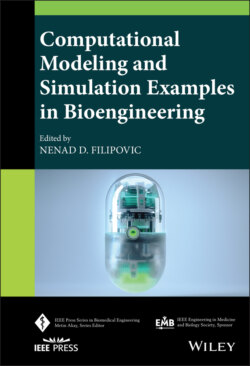Читать книгу Computational Modeling and Simulation Examples in Bioengineering - Группа авторов - Страница 18
1.5 Material Properties of the Aorta Wall
ОглавлениеIt is very important to use arterial wall with proper material model because the wall stiffness increases when lumen diameter increases and calcification and medial sclerosis occur with aging and disease. The aneurysmal wall has been found to be mechanically anisotropic [74]. Isotropic properties assumption is a reasonable assumption in most cases. A more accurate constitutive model is needed to describe the properties of the wall.
The flat arterial tissue layer is assumed to be a fiber‐reinforced material with relatively stiff collagenous fibers embedded in a homogeneous isotropic (soft) ground matrix [75]. The assumption of strain energy functions holds good only for single continuous medium tissues which is not the case with arterial tissue [76]. The mechanical properties of soft biological tissues depend greatly on their microstructure integration attained in the constitutive model [49]. Taghizadeh et al. [77] proposed a new biaxial constitutive model based on microstructural properties as opposed to the simple uniaxial tests carried out by Sokolis et al. [78] and Karimi et al. [79]. Wall thickness is also very important. Since aneurysmal rupture occurs at a specific site of the aortic lumen, the properties of the wall affect the computed solution. The aortic wall thickness in computational methods is assumed to be in the range of 1.5–2 mm. While this may be largely accurate for most simulations, it has been acknowledged as a major limitation in the completeness of the prediction solution [80]. Raut et al. [81] suggested that the wall thickness as a constant value is not accurate and described a novel method that incorporated the regionally varying wall thickness, especially in the area of rupture.
